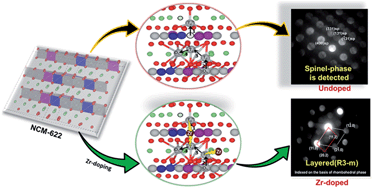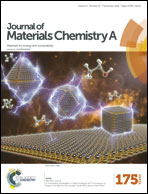Stabilizing nickel-rich layered cathode materials by a high-charge cation doping strategy: zirconium-doped LiNi0.6Co0.2Mn0.2O2†
Abstract
Ni-rich layered lithiated transition metal oxides Li[NixCoyMnz]O2 (x + y + z = 1) are the most promising materials for positive electrodes for advanced Li-ion batteries. However, one of the drawbacks of these materials is their low intrinsic stability during prolonged cycling. In this work, we present lattice doping as a strategy to improve the structural stability and voltage fade on prolonged cycling of LiNi0.6Co0.2Mn0.2O2 (NCM-622) doped with zirconium (+4). It was found that LiNi0.56Zr0.04Co0.2Mn0.2O2 is stable upon galvanostatic cycling, in contrast to the undoped material, which undergoes partial structural layered-to-spinel transformation during cycling. The current study provides sub-nanoscale insight into the role of Zr4+ doping on such a transformation in Ni-rich Li[NixCoyMnz]O2 materials by adopting a combined experimental and first-principles theory approach. A possible mechanism for a Ni-mediated layered-to-spinel transformation in Ni-rich NCMs is also proposed.



 Please wait while we load your content...
Please wait while we load your content...